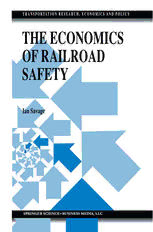
The Economics of Railroad Safety PDF
Preview The Economics of Railroad Safety
The Economics of Railroad Safety Transportation Research, Economics and Policy VOLUME 7 Editorial Board Yossi Berechman Department of Economics & Public Policy, Tel Aviv University, Israel Kenneth Small Department of Economics, University of California at Irvine, U.S.A. The titles published in this series are listed at the end of this volume. The Economics of Railroad Safety By IAN SAVAGE Department of Economics and the Transportation Center Northwestern University SPRINGER SCIENCE+BUSINESS MEDIA, LLC Library of Congress Cataloging-in-Publication Data Savage, Ian, 1960- The economics of railroad safety / by Ian Savage. p. cm. — (Transportation research, economics and policy ; v. 7) Includes bibliographical references and index. ISBN 978-1-4613-7548-7 ISBN 978-1-4615-5571-1 (eBook) DOI 10.1007/978-1-4615-5571-1 1. Railroad accidents—United States. 2. Traffic safety—United States. I. Title. II. Series. HE1780.S28 1998 363.12,2'0973-dc21 98-8616 CIP Copyright ® 1998 by Springer Science+Business Media New York Originally published by Kluwer Academic Publishers in 1998 Softcover reprint of the hardcover 1st edition 1998 All rights reserved. No part of this publication may be reproduced, stored in a retrieval system or transmitted in any form or by any means, mechanical, photo-copying, recording, or otherwise, without the prior written permission of the publisher, Springer Science+Business Media, LLC. Printed on acid-free paper In Memory of my Grandmother Madge Lucy Grinyer 1911-1996 CONTENTS Abbreviations ix Preface xi Acknowledgements xiii 1 Setting the Scene 1 2 Historical Trends 11 3 Public Policy 21 4 How Safe are American Railroads? 29 5 Risk Evaluation 33 6 The Story So Far 43 7 Economic Theory of Bilateral Accidents 47 8 Highway Grade Crossings 59 9 Trespassers 73 10 Occupational Injuries 79 11 Benchmark Levels of Operational Safety 93 12 Market Power 99 viii Ian Savage 13 Imperfect Information 105 14 Customer Rationality 113 15 Railroad Myopia 115 16 Externalities 123 17 Non-Regulatory Responses 131 18 Federal Safety Regulations 139 19 Evaluation of Regulations 149 20 A New Era for Safety Regulation 165 21 The Way Forward 197 Appendix A Federal Regulations 211 Appendix B Historical Data 217 References 219 Subject Index 227 ABBREVIATIONS AAR Association of American Railroads ASLRRA American Short Line and Regional Railroad Association CFR Code of Federal Regulations DOT United States Department of Transportation EPA United States Environmental Protection Agency FHWA United States Federal Highway Administration FRA United States Federal Railroad Administration GAO United States General Accounting Office ICC United States Interstate Commerce Commission NHTSA United States National Highway Traffic Safety Administration NTSB United States National Transportation Safety Board OHSA United States Occupational Health and Safety Administration OTA United States Office of Technology Assessment TRB Transportation Research Board PREFACE The American public has a fascination with railroad wrecks that goes back a long way. One hundred years ago, staged railroad accidents were popular events. At the Iowa State fair in 1896, 89,000 people paid $20 each, at current prices, to see two trains, throttles wide open, collide with each other. "Head-on Joe" Connolly made a business out of "cornfield meets" holding seventy-three events in thirty-six years. Picture books of train wrecks do good business presumably because a train wreck can guarantee a spectacular destruction of property without the messy loss of life associated with aircraft accidents. A "train wreck" has also entered the popular vocabulary in a most unusual way. When political manoeuvering leads to failure to pass the federal budget, and a shutdown is likely of government services, this is widely called a "train wreck. " In business and team sports, bumbling and lack of coordination leading to a spectacular and public failure to perform is also called "causing a train wreck." A person or organization who is disorganized may be labelled a "train wreck. " It is therefore not surprising that the public perception of the safety of railroads centers on images of twisted metal and burning tank cars, and a general feeling that these events occur quite often. After a series of railroad accidents, such as occurred in the winter of 1996 or the summer of 1997, there are inevitable calls that government "should do something. " However, the reality of railroad safety is much different from the perception. The major safety issues are not collisions or derailments, but rather occupational injuries to employees, collisions with negligent road users at highway grade crossings, and the general proclivity of people to trespass on the railroad. Contrary to popular perception, accident rates have fallen throughout the twentieth century. Employee injury rates are a third of those of a generation ago, and grade crossing fatalities per automobile owned have fallen by half over the same period. It is ten times safer to travel by train than to drive. Yet the railroads are subject to considerable safety regulation. It may come as somewhat of a shock to many readers to realize that much of this regulation is quite recent. Back in those halcyon days when passenger trains were the primary means of long-distance travel, the industry had little formal governmental regulation but substantial self regulation. Then in 1970 the Federal Railroad Safety Act gave government rulemaking authority over "all areas of railroad safety." Nowadays the Code of Federal Regulations reads like an engineering textbook on how to build, maintain and operate a railroad. XlI Ian Savage A generation ago, transportation economists were at the forefront of questioning whether economic regulation of prices and quantity of service by government was in the public interest. This book explores whether similar questions can be raised about regulation of the quality of service: What is the justification for the current safety regulations of the railroads? Why did it happen? Are the current regulations in the public interest? Are there better alternatives?
